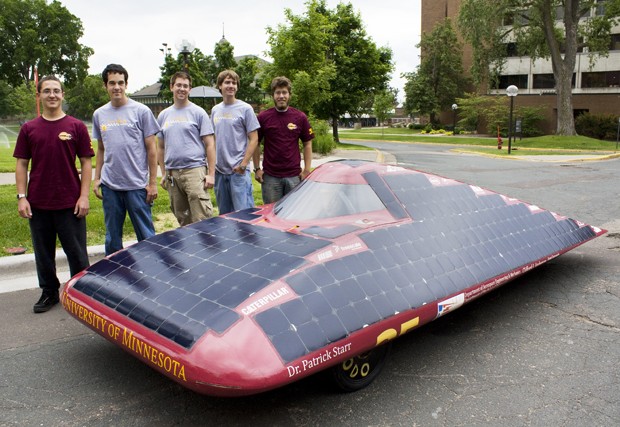While automakers across the country struggle, in the garage behind the Engineering and Fisheries Lab at the University of Minnesota, car production is flourishing, for solar cars, at least. The lab is home to the UniversityâÄôs Solar Vehicle Project and their vehicle Centaurus , winner of the 2009 Sun Formula Grand Prix that took place at the MotorSport Ranch in Cresson, Texas on June 3-5 . Centaurus runs on power derived solely from the sun, and won the race by completing 487 1.7-mile laps, 94 more than the second place competitor from the University of Kentucky. The car is the eighth generation of University of Minnesota solar vehicles, and the third in a row to win the Grand Prix. Adam Shea , one of the 40 undergraduate engineering students that comprise the UniversityâÄôs solar vehicle team said the vehicle averaged a speed of 50 mph. Of the 17 team members that attended the Formula Sun Grand Prix only three had previously raced a car. One of the teamâÄôs primary goals in the race was to train new project members. Crew chief Adem Rudin said the new members adjusted well to the challenges of racing. He said challenges include âÄúthe heat, the boredom and the stress.âÄù Racing started at 8 a.m. each morning, and ran until 4 p.m. Drivers took an average of three-hour shifts inside the cockpit, where temperatures reached 110 degrees. However, Rudin said the race is practice for the more intense North American Solar Challenge, which will take place in July 2010. The race covers 2,400 miles, starting in Dallas, Texas and ending in Calgary, Alberta. For the 2010 Solar Challenge the team will be driving a new car, Centaurus II, which is still in the blueprint stages. Centaurus II will improve upon its predecessor, which Shea said ran âÄútoo wellâÄù in the 2009 Formula Sun Grand Prix. The car was receiving so much power that the team had to disconnect the solar array at one point. The array consists of 530 silicon solar cells, producing around 1500 Watts of powe r on a sunny day. The team is especially proud of the carâÄôs electrical system, which was built entirely by students, Rudin said. The car is a product of generous donations of cash, material and time, he said. The project receives approximately $300,000 in donations. Team members volunteer around 90 hours a week before races and 30 hours during the school year, Shea said. Todd Reubold, director of communications at the Institute on the Environment, which is one of the sponsors of the Solar Vehicle Project, said the teamâÄôs win is a âÄúfabulous testament to the studentâÄôs work and the solar program here at the U.âÄù Reubold said he felt that there is an opening for development of solar power for mainstream use. He noted advertising for the new Toyota Prius with a solar panel as an example of solar energy marketed at a general audience. Rudin said the mainstream use of purely solar-powered cars is unlikely, because of their unreliability. He said he thinks the future of solar power is on roofs of parking garages and houses, as a way to charge carâÄôs batteries. âÄúBattery technology is flying ahead by leaps and bounds. The battery in Centaurus can go 250 miles with no sun,âÄù Rudin said. Shea predicts a bright future for solar power. He said the market for solar cells is seeing âÄúmore demand than supply.âÄù For now, the team enjoys the novelty of the vehicle. Rudin said, âÄúDriving down the highway everyone honks and waves âĦ youâÄôre the star of the show.âÄù



